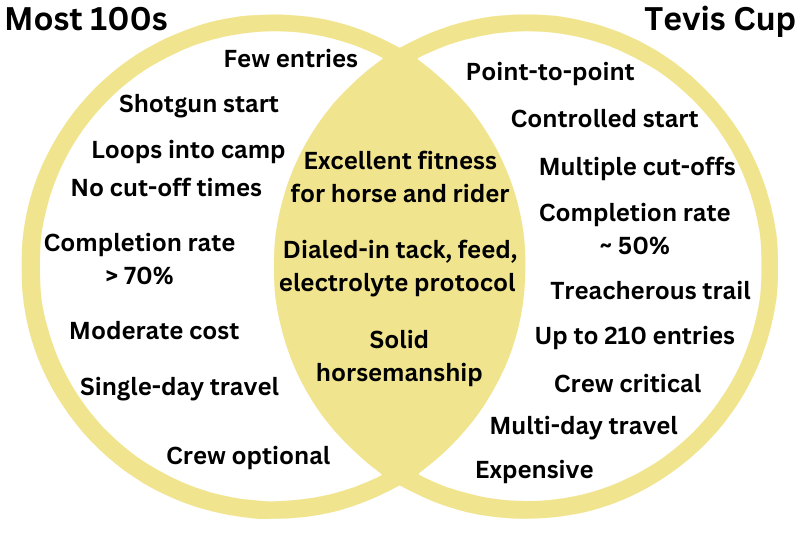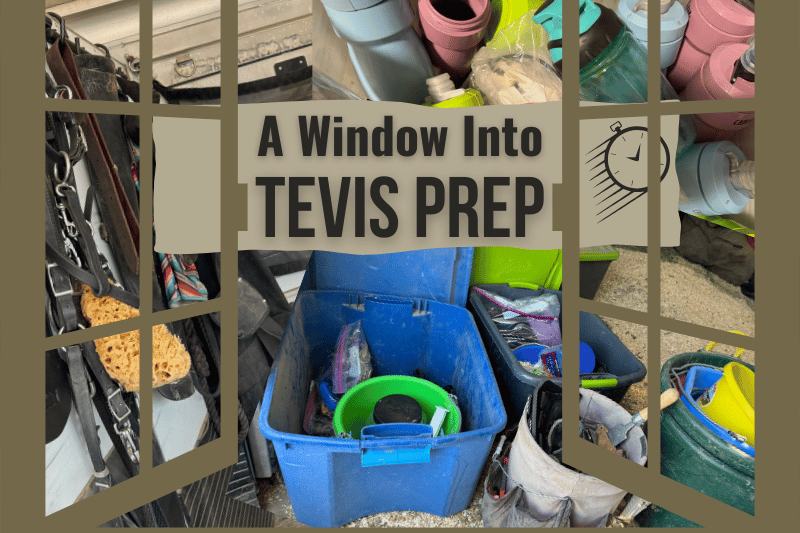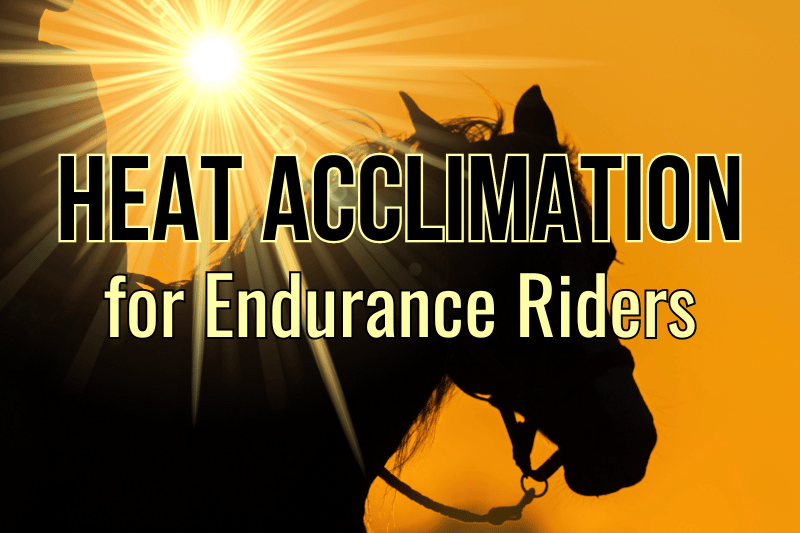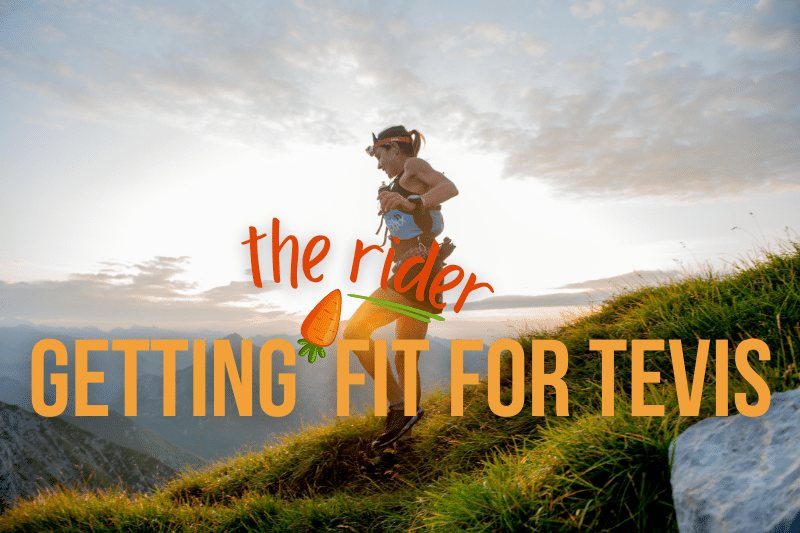Preparing for Tevis is just like preparing for any other endurance ride.
Okay, it’s not.
Okay, it is…but it isn’t.
If you’ve ever wondered what it’s like to get ready for Tevis, here’s a window into the process. This is my first time, so I’m no expert, but I’ve learned a lot from my very experienced crew and other friends who have ridden The Big Ride before.
I’m a naturally-organized, detail-oriented, plan-and-execute sort of personality, so this kind of project management is right up my alley. This post shares some of the strategies and solutions that have gotten me, still mostly sane, to the day before departure.
Where Do I Even Start?
Only a few hours after Layne’s accident at Eagle Canyon, while I was still in ride camp, she sent word: I was to take over Atlas for the year. His year was to include Tevis.
Holy smokes, really?
The trip was already on my calendar, as I’d been slated to crew. It would be my inaugural Tevis experience. A chance to learn the ropes.
Now, I’d be in the saddle instead.
Aaaaaaaah! Where do I even start?
I began by considering what was same as any other hundred, versus what was unique about Tevis. Things like this:

The big blocks – the real basics like horsemanship and fitness – are the same. However, Tevis puts it all on steroids. The stakes are higher. There’s more money spent, more risk to horse and rider, more friends and family giving up a week of their lives to support the team.
These higher stakes, plus the logistical challenges that come with a point-to-point ride supported by multiple crew members, turned my usual endurance ride packing routine into a multi-week project.
I started, of course, with my standard endurance ride packing list. (Need one? It’s free!)
Riding clothes, tack, a little tech, a little snack. Blah blah, the usual…
Now, throw in extra of everything:
A full change of riding clothes for Foresthill. Spare reins, cinch, and stirrup leathers in case something breaks. Battery chargers for watch and phone during the hold. Serious sports nutrition to support 20+ hours in the saddle.
Oh, and we’ll be traveling a lot longer than usual. That means more casual clothes, meals, and toiletries.
Plus, crew! Where will they eat and sleep? And how about an actual plan for ride day? Who will go where, and do what? Do they know how to get there? How long are the drives? What supplies will they need? What supplies will I need?
Oh, and how about that heat and altitude and extended effort? Am I physically fit to stay strong for Atlas through it all?
Getting Organized (AKA Staying Sane)
You know that old expression about eating an elephant? One bite at a time, folks. One bite at a time.
To preserve my sanity, I created a note in my phone where I could jot down Tevis-related reminders as they came to me day and night. Siphoning this stuff off my brain allowed me to remain focused on what I was actually doing, while ensuring that I would circle back.
I also created a spreadsheet to organize all those random reminders. It inclues to-do lists that are color-coded by responsible individual, shopping lists, a timeline for the trip itself, and various packing lists.
I hate the feeling of mentally juggling a lot of important tasks while I’m in a rush. No way do I want to spend Friday in ride camp trying to get organized, wondering where the BodyGlide is and whether I remembered to buy carrots.
So, I’ve pre-packed nearly everything exactly as it will be needed during the ride. This includes my saddle bags, crew kits for Robinson Flat, Michigan Bluff, and Foresthill, and even a shower kit in case I have the energy to bother cleaning up at the finish.
I also have my ride-day clothes all together in a ziploc, plus a stocked Remember-Me Box (which I cover in my Step-by-Step Guide to Your First Endurance Ride).
Solving Problems Before they happen
I put a lot of thought into identifying potential problems and solving them in advance. After all, factors that are a minor annoyance during a fast, desert 50 can become serious issues during a long, mountain 100.
For example:
Heat Rash
I tend to get heat rash during summer rides. This doesn’t sound like a big deal, except I get the kind that becomes very painful and takes a week to resolve. Mostly, this occurs under my half chaps (yes, even them mesh kind).
The obvious solution is to replace my half chaps with something more breathable. However, that requires replacing the protection offered by the half chaps with…what?
I settled on merino wool ski socks that go up to my knees and have a double-thick layer to pad my shins.
Of course, that leaves the tops of my boots open to collect debris, which could be a real problem because I plan to run down and tail up the canyons. Trail running gaiters to the rescue!
This kind by Altra is very lightweight and stays in place well, but they require sticking a Velcro patch to the outside heel of your shoe. They didn’t adhere well to my boots, so I helped them out with a smear of Loctite Flexible Adhesive. Hopefully, that will hold – but I threw the tube of glue into my Robinson Flat kit, just in case.
The rest of my anti-heat-rash arsenal includes a slathering of hydrocortisone cream, followed by zinc oxide ointment. I also take a loratadine tablet. This combination seems to do the trick!
For a ride this long and hot, I’m hedging my bets by sending kits containing anti-bacterial wipes, hydrocortisone, and zinc oxide out to both Robinson and Foresthill. My theory is that I can take them to the porta-potty for a quick reapplication while my fabulous crew handles Atlas.
Head Tossing
Speaking of Atlas, you might recall that during our 100 at the Mary and Anna Memorial Ride, things got downright dangerous when he took his impatient head-tossing to an extreme.
Layne and I knew we needed to find a solution right away! A series of lessons with Linda Kaye Hollingsworth-Jones at Willow Grove Conservatory showed promise for a long-term solution – one addressing the root cause – but we knew a short term fix would be necessary in the meantime.
After some experimentation, we found that Atlas responded well to a thinner, lighter snaffle combined with a slider running martingale from Distance Depot. The sliding martingale allows more lateral head motion than a standard running martingale while safeguarding against excessive vertical motion.
That combination worked really well during our recent 50 at Strawberry Fields Forever. Martingales aren’t my favorite solution, and they’re kind of a pain whenever you want to get off and lead the horse, but I’m very grateful to be headed into Tevis without worrying about Atlas getting over the bit and out of control.
Ride Day Fuel
I’m not one to have a sandwich during an endurance ride. My stomach just can’t take that much volume while I’m trotting down the trail. Normally, I can get away with just a small amount of calorie-dense food at each hold, even during a 100. I generally don’t feel like eating much until a few hours after the finish.
Tevis, though… This ride is bound to take longer than the other 100s I’ve done. Plus, despite having more than the usual number of vet checks, it has only two actual holds. The upshot is that I need to find a way to fuel myself steadily throughout the ride.
The trick is to find nutrition that is portable, non-perishable, easy to eat while riding (not melted, crumbly, or sticky), easy on my stomach, and appealing even after hours of effort in the heat. Here’s what I came up with:
UCAN Sports Nutrition products contain a special “super starch” called Livsteady that provides steady-release energy instead of the blood sugar spike-and-crash that results from glucose-based products. I’ll be using:
Salted Peanut Butter Energy Bars – These are tasty and small, gentle on my stomach, and non-melting. I’ll eat one at each hold and carry another on my saddle.
Lemon Energy Powder – This is basically just Livsteady with some flavoring. Mixed in one of my water bottles, it provides a consistent drip of fuel that’s easy to consume on the trail even if I don’t feel like eating.
Pineapple Edge Energy Gels – I normally use these gels for distance running more than riding, but they’re a great way to get some fuel into an unhappy stomach. Again, they feature Livsteady instead of sugar so they aren’t sickly sweet. I’ll have a couple on my saddle all day in case I need them.
I’ll also have a selection of other food items available, including: applesauce pouches, Mama Chia pouches, Larabars, almond packets, various trail mixes (including spicy ones, which can be a nice change from the typical sweet-leaning nature of race fuels), Paleo sticks, and whatever fresh produce my excellent crew has handy.
For electrolytes, I’ll be using LMNT during the heat of the day. Containing 1,000 mg of sodium per packet (as opposed to the more common 300 mg or so) LMNT is a superhydrator. This is perfect for replacing the dramatic losses that will occur as Atlas and I forge through the canyons.
If you want to try some, LMNT will send you a free sample pack with any order (even just another sample pack!) when you use my link.
If you happen to be at Tevis, find me at Robie Equestrian Park – look for The Sweaty Equestrian logo on my trailer – or Layne at Foresthill and we’ll give you a packet of LMNT along with some TSE swag!
For a milder electrolyte that also supports muscle recovery, I’ll use UCAN’s Hydrate Plus Aminos during the morning and again into the night. This powder contains 300 mg of sodium per serving, plus essential amino acids like glutamine (for tissue repair) and betaine (for fat utilization to support extended effort).
By the way, if you want to try UCAN, use my link to get the best deal and support the blog at the same time!
I’ll also be sending some strong iced coffee out to the checks. Especially when consumed with chocolate, caffeine can alter adenosine uptake in a manner that blocks fatigue, improves appetite, and keeps adenosine available to produce muscle-fueling ATP.
This is why Coke and M&Ms are a popular combination among ultra-runners. Not being a soda or candy fan, however, I’ll stick with coffee and some Lindt. I also grabbed some of these nifty mints with caffeine and l-theanine for myself and my crew.
So much to remember, so little time
Goodness, there’s so much more!
I don’t have time to talk about designing team shirts (fun!), testing new stirrups (Burioni Flexias, which I’ll review for you after Tevis), preparing the farm for my absence, writing bios for the livecast folks, truck and trailer maintenance…all the things!
And don’t forget the Tevis rider fitness plan and heat acclimation methods covered in previous posts. I really did implement those strategies, and I’m confident that my mid-forties bod is as ready as it’s going to be.
As for my mind…you all have been a tremendous help. I can’t tell you how much your words of support have bolstered my confidence – not only that Atlas and I can do this, but also that it’s okay if luck isn’t on our side. I’m going into this believing we have a really good shot at completion, and knowing that we’ll have an epic adventure no matter what.
This is the last blog post that will publish before Tevis. Stay tuned to The Sweaty Equestrian Facebook page for updates as we travel. We are planning for Atlas’ owner, Layne Lewis, to take over the Facebook page on ride day. If our Starlink technology works as hoped, she’ll provide updates from her post at Foresthill. I will send word from the trail to y’all if I can…and if I can’t, just know how very much I appreciate you and stay tuned for the full story!
You might also like
This post includes affiliate links, and I may earn a small commission (at no extra cost to you) when you purchase through these links. I only recommend products and services I think are helpful and useful. Thanks for helping me offset the cost of maintaining this blog as a free resource!






